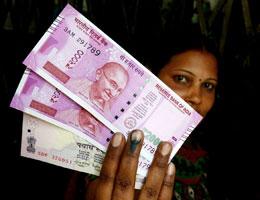Even Harvard’s expert on demonetisation has no idea how it will play out in India

Photo caption: Show me the money. (EPA/Jagadeesh NV)
By Devjyot Ghoshal,
Special to The Post
Nearly two weeks later, India is still deeply divided over Narendra Modi’s radical move to pull out the Rs500 and Rs1,000 notes from circulation.
The inconvenience and pain of demonetisation have been evident: People have died in long queues outside banks, the informal economy is at a near standstill, and money is in short supply. Much of this is a manifestation of shoddy implementation and questions are being raised over what all this is worth.
The government’s argument has been straightforward: By taking two of India’s biggest currency denominations out of circulation, it hopes to be able to clamp down on black money, thereby curbing corruption, improving tax compliance, and choking terror-funding.
Yet, even one of the world’s leading authorities on demonetisation isn’t quite sure of how Modi’s massive gamble will play out. Kenneth Rogoff, professor of public policy and economics at Harvard University, whose 2016 book The Curse of Cash makes a case for partly phasing out paper money, explained in a blogpost late last week:
Will Modi’s plan work? Despite apparent huge holes in the planning (for example, the new notes India is printing are a different size and do not fit the ATM machines), many economists feel it could still have large positive effects in the long-run, shaking up the corruption, tax evasion, and crime that has long crippled the country. But the long-run gains depend on implementation, and it could take years to know how history will view this unprecedented move.
The short run costs are unfolding, but the long-run effects on India may well prove more than worth them, but it is very hard to know for sure at this stage.
Rogoff’s main thesis in The Curse of Cash—somewhat mirroring the Modi government’s argument—is that much of the physical currency in a country, particularly high denomination notes, is held in the underground economy, which fuels tax evasion and crimes of all kinds.
However, there are key differences between Rogoff’s proposals and the process underway in India. For one, his plan isn’t aimed at developing countries like India where a massive proportion of people do not have proper access to the formal banking system.
Neither is Rogoff a votary of phasing out notes overnight, which is how India went about it. “First, I argue for a very gradual phase-out, in which citizens would have up to seven years to exchange their currency, but with the exchange made less convenient over time. This is the standard approach in currency exchanges,” he wrote.
“Second,” Rogoff added, “my approach eliminates large notes entirely. Instead of eliminating the large notes, India is exchanging them for new ones, and also introducing a larger, 2000-rupee note, which is also being given in exchange for the old notes.”
Nonetheless, even replacing them has benefits similar to entirely eliminating large denomination notes. “Anyone turning in large amounts of cash still becomes very vulnerable to legal and tax authorities. Indeed, that is Modi’s idea,” Rogoff explained. “And criminals have to worry that if the government has done this once, it can do it again, making large notes less desirable and less liquid.”
Devjyot Ghoshal (@devjyotghoshal) is a roving editor with Quartz India, our partnership with Scroll. Prior to joining in 2014, he spent a year at the Columbia Journalism School as a Fulbright scholar. He cut his teeth with Business Standard, an Indian financial daily, in its Delhi, Kolkata, and Singapore offices, where he worked as a staff reporter and Southeast Asia correspondent.
This piece was originally appeared in Quartz (qz.com).









